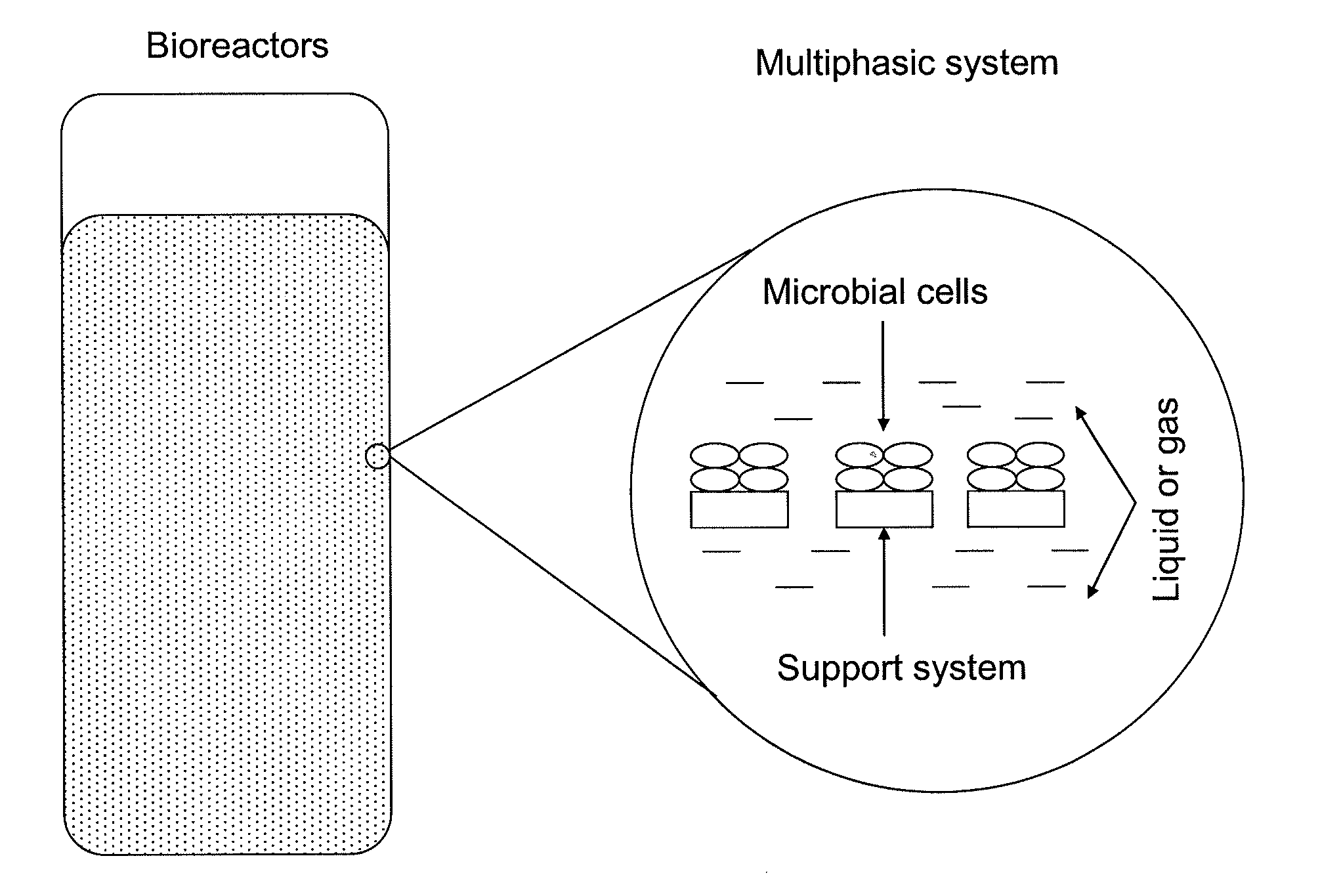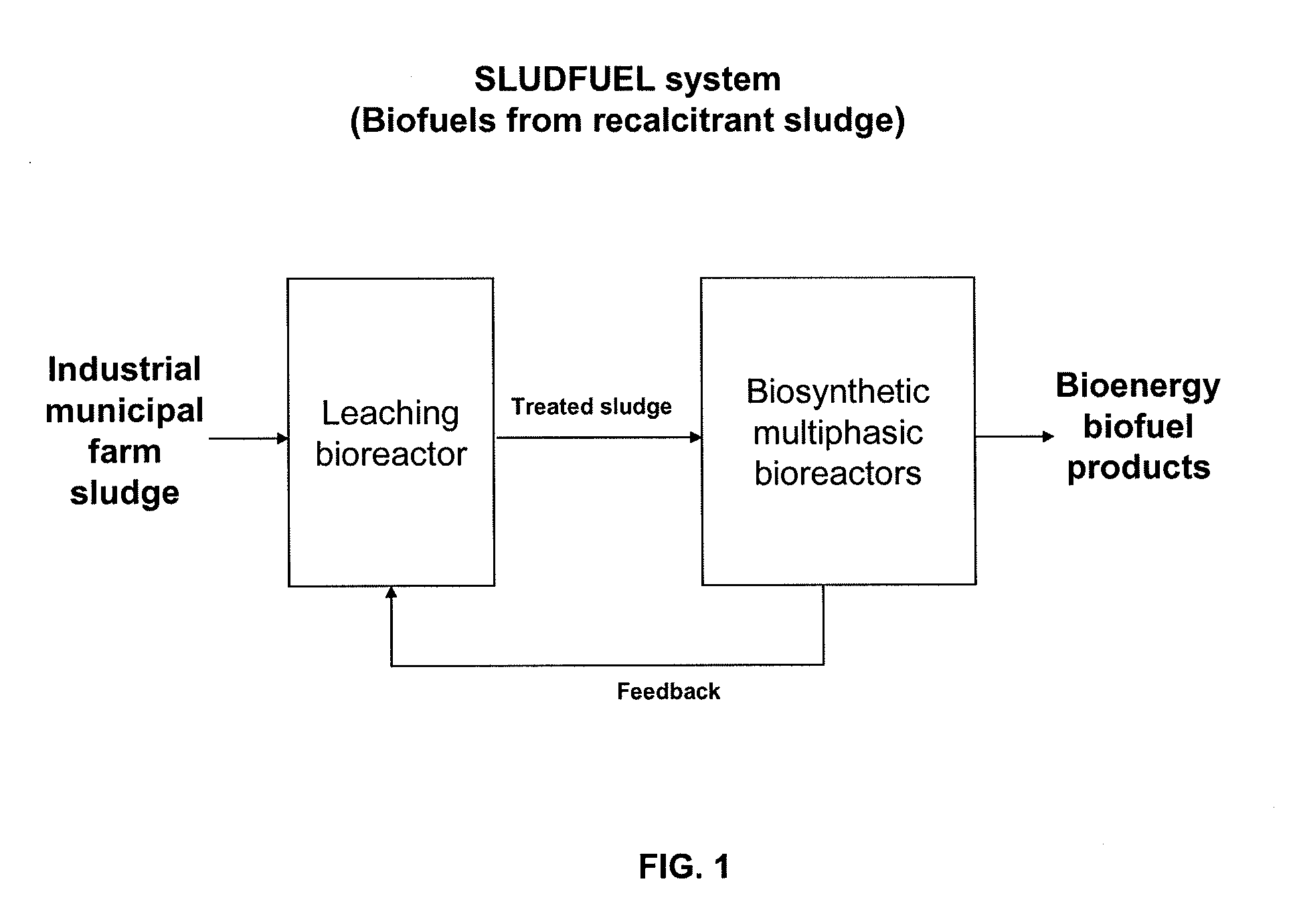Methods and systems for production of biofuels and bioenergy products from sewage sludge, including recalcitrant sludge
a technology applied in the field of biofuels and bioenergy products, can solve the problems of affecting the use of sewage sludge, and the physical and/or chemical character of sewage sludge is generally considered unsuitable for microbial processing
- Summary
- Abstract
- Description
- Claims
- Application Information
AI Technical Summary
Benefits of technology
Problems solved by technology
Method used
Image
Examples
example 1
Testing of a Bioleaching Reactor for the Removal of Heavy Metals from Sewage Sludge
[0109]This example demonstrates that heavy metals from sewage sludge can be removed using a bioleaching reactor. The sewage sludge contained high levels of heavy metals including Pb, Cd, Cu, Hg, and Zn. When sludge is disposed as biosolids in soil, the heavy metals are accumulated in soil and can be transferred to the plant cultures.
[0110]An alternative to chemical processes for removing heavy metals is microbial leaching with certain bacteria species. Bioleaching in accordance with the invention has several advantages over chemical methods in terms of its simplicity, high yield of metal extraction, lower acid and alkali consumption, and minimum reduction in sludge nutrients such as N and P.
[0111]The activity of leaching bacteria can be enhanced with additive Fe(II) as the source substance for Thiobacillus sp. bacteria. The sulfur-oxidizing bacteria are naturally available in the sludge samples and ca...
example 2
Testing of a Multiphasic Bioreactor for the Production of Methane from Treated Sewage Sludge
[0114]This example shows that the treated (by bioleaching) sewage sludge can be efficiently digested to produce methane. The aim of bioleaching treatment is to improve or allow the anaerobic digestion of the sludge, where high concentrations of heavy metals otherwise make sludge recalcitrant to anaerobic digestion.
[0115]Batch tests were performed in a 1-L UASB anaerobic reactor to assess sludge biodegradability and production of methane. The reactor was fed with sludge previously treated to remove heavy metals by the bioleaching process. A bacteria consortium of a previous digested sludge was used as inoculums. Treated sludge, non-treated sludge, as well as a control sample consisting of ethanol, were digested. The organic matter was equivalent to 8 g COD / L in all samples.
[0116]The biogas volume produced was measured by movement of liquid (water, pH 2, NaCl 10%). Biodegradability was assessed...
example 3
Testing of a Multiphasic Bioreactor System for the Production of Ethanol from Treated Sewage Sludge
[0119]This example demonstrates the production of ethanol from treated (heavy metals removed) sewage sludge.
[0120]A 1-L bioreactor containing 500 ml of sludge (8 g COD / L) was inoculated with a selected culture of the yeast of Saccharomyces sp. A control system containing glucose as carbon source was used to compare with treated and non-treated sludge samples. The reactor was maintained at 28° C. agitated only by recirculation. Samples were collected and analyzed every 12 hours for 3 days for COD and ethanol production.
[0121]The results show that ethanol production followed the growth curve of Saccharomyces sp. until stationary phase is reached. The ethanol therefore reached its maximum production after 48 hours after which production decreased.
[0122]As can be observed in FIG. 7, after 48 hours of culture, approximately 30% and 20% of COD was converted to ethanol using the treated and u...
PUM
 Login to View More
Login to View More Abstract
Description
Claims
Application Information
 Login to View More
Login to View More - R&D
- Intellectual Property
- Life Sciences
- Materials
- Tech Scout
- Unparalleled Data Quality
- Higher Quality Content
- 60% Fewer Hallucinations
Browse by: Latest US Patents, China's latest patents, Technical Efficacy Thesaurus, Application Domain, Technology Topic, Popular Technical Reports.
© 2025 PatSnap. All rights reserved.Legal|Privacy policy|Modern Slavery Act Transparency Statement|Sitemap|About US| Contact US: help@patsnap.com



